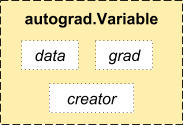Autograd: automatic differentiation¶
Central to all neural networks in PyTorch is the autograd package.
Let’s first briefly visit this, and we will then go to training our
first neural network.
The autograd package provides automatic differentiation for all operations
on Tensors. It is a define-by-run framework, which means that your backprop is
defined by how your code is run, and that every single iteration can be
different.
Let us see this in more simple terms with some examples.
Variable¶
autograd.Variable is the central class of the package. It wraps a
Tensor, and supports nearly all of operations defined on it. Once you
finish your computation you can call .backward() and have all the
gradients computed automatically.
You can access the raw tensor through the .data attribute, while the
gradient w.r.t. this variable is accumulated into .grad.

Variable
There’s one more class which is very important for autograd
implementation - a Function.
Variable and Function are interconnected and build up an acyclic
graph, that encodes a complete history of computation. Each variable has
a .grad_fn attribute that references a Function that has created
the Variable (except for Variables created by the user - their
grad_fn is None).
If you want to compute the derivatives, you can call .backward() on
a Variable. If Variable is a scalar (i.e. it holds a one element
data), you don’t need to specify any arguments to backward(),
however if it has more elements, you need to specify a grad_output
argument that is a tensor of matching shape.
import torch
from torch.autograd import Variable
Create a variable:
x = Variable(torch.ones(2, 2), requires_grad=True)
print(x)
Do an operation of variable:
y = x + 2
print(y)
y was created as a result of an operation, so it has a grad_fn.
print(y.grad_fn)
Do more operations on y
z = y * y * 3
out = z.mean()
print(z, out)
Gradients¶
let’s backprop now
out.backward() is equivalent to doing out.backward(torch.Tensor([1.0]))
out.backward()
print gradients d(out)/dx
print(x.grad)
You should have got a matrix of 4.5. Let’s call the out
Variable “\(o\)”.
We have that \(o = \frac{1}{4}\sum_i z_i\),
\(z_i = 3(x_i+2)^2\) and \(z_i\bigr\rvert_{x_i=1} = 27\).
Therefore,
\(\frac{\partial o}{\partial x_i} = \frac{3}{2}(x_i+2)\), hence
\(\frac{\partial o}{\partial x_i}\bigr\rvert_{x_i=1} = \frac{9}{2} = 4.5\).
You can do many crazy things with autograd!
x = torch.randn(3)
x = Variable(x, requires_grad=True)
y = x * 2
while y.data.norm() < 1000:
y = y * 2
print(y)
gradients = torch.FloatTensor([0.1, 1.0, 0.0001])
y.backward(gradients)
print(x.grad)
Read Later:
Documentation of Variable and Function is at
http://pytorch.org/docs/autograd
Total running time of the script: ( 0 minutes 0.000 seconds)